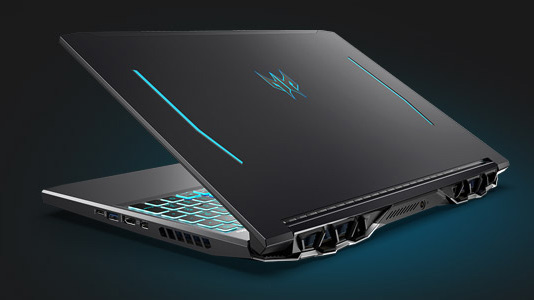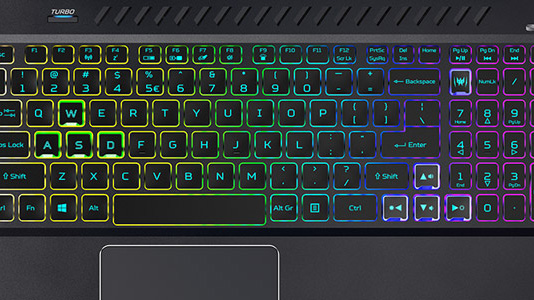Tom's Guide Verdict
While the Acer Predator Helios 300 laptop has strong game performance, it’s held back by loud fans and a frustrating keyboard.
Pros
- +
Good game performance
- +
Powerful hardware
- +
Lots of configuration options
Cons
- -
Abysmal keyboard
- -
Very loud fans
- -
Expensive
Why you can trust Tom's Guide
CPU: 10th-gen Intel Core i7-10750H at 2.60 GHz, 6 cores
GPU: Nvidia GeForce RTX 2060
Display: 15.6 inches, 1920 x 1080
RAM: 16 GB
Storage: 512 GB SSD
Dimensions: 14.3 x 10.0 x 0.9 inches
Weight: 5.5 pounds
The Acer Predator Helios 300 gaming laptop looks good on paper. No matter which configuration you buy, it packs some extremely powerful hardware, along with easy hookups for bigger displays, a screen with a fast refresh rate and a full number pad on its keyboard. But while the Helios 300 does indeed run games very well, it’s held back by a number of major problems.
Productivity on a Helios 300 is difficult, thanks to a truly dreadful keyboard, extremely loud fans and a middling battery life. The Acer Predator software doesn't do anything terribly exciting, and the speakers are subpar. With inconveniently placed ports and a bulky build, the Helios 300 isn't that easy to transport, either.
At the end of the day, the Helios 300 does play games very well, and offers a wide range of configuration options. But in the same price range, you could get some of the best gaming laptops, including the much better Acer Predator Triton 500.
Learn more in our full Acer Predator Helios 300 review.
Acer Predator Helios 300: Price and configuration options
The Acer Predator Helios 300 has a staggering amount of different configurations. On the Acer website alone, I counted 21 different variations.
The cheapest model we found was the Predator Helios 300 PH317-52-716C, which costs $1,000. It features an Intel Core i7-8750H, 2.2 GHz processor, an Nvidia GeForce RTX 1050Ti GPU, 8 GB RAM, a 256 GB SSD and a 17.3-inch screen with a 1080p display and 144 Hz refresh rate.
At the other end of the spectrum, there's the Predator Helios 300 PH317-53-77X3, which costs $2,400. This model comes with an Intel Core i7-9750H, 2.6 GHz processor, an Nvidia GeForce RTX 2070 GPU, 32 GB Ram, a 512 GB SSD and a 17.3-inch screen with a 1080p display and a 144 Hz refresh rate.
Our review model, the Predator Helios 300 PH315-53-72XD, came with an Intel Core i7-9750H, 2.6 GHz processor, an Nvidia GeForce RTX 2060 GPU, 16 GB RAM, a 512 GB SSD and a 15.6-inch screen with a 1080p display and a 144 Hz refresh rate.
If these specs give you the impression that Helios 300 pricing and configuration options are complicated, you're correct. There's not much rhyme or reason to the pricing, and it's not clear how many more variations — like our review unit — might be waiting in the wings. Since you can't customize any of the models, you'll have to pick one that suits your needs. Given the heftier pricing, it's well worth checking for an Acer promo code to see if you can save a few dollars on your purchase.
Acer Predator Helios 300: Design
Aesthetically, the Acer Predator Helios 300 resembles many other Predator laptops. It's got a black metal chassis with two reflective strips and a Predator logo on the back, all lined in blue. At 14.3 x 10.0 x 0.9 inches, the computer is admirably compact, given the size of its screen. But at 5.5 pounds, it's a little heavier than the competition (comparable Acer and Alienware laptops weigh around 4.5 pounds).

There are also enough ports to get the job done, although I wasn't thrilled with their configuration. The left side has a headphone jack, two USB-A ports and an Ethernet port; the right side has a USB-C port, a USB-A port, an HDMI port and a mini DisplayPort. The power port is on the back of the machine, out of everything else's way.

The proximity of the USB-C and -A ports on the right made it tough to attach any gadget that required a USB-C dongle while using a mouse — and you really need to use a mouse, because the touchpad is not great.
Acer Predator Helios 300: Keyboard and touchpad
If there's one reason to avoid the Acer Predator Helios 300 at all costs, it's the keyboard. At first, I was excited by the keyboard's numpad — a rarity in 15-inch laptops. But numpads don't make much of a difference if the keyboard isn't comfortable, and the Predator Helios 300 makes productivity typing just about impossible. Worse still: to facilitate the numpad, the rest of the keyboard is off-center, meaning that you'll have to position the whole laptop slightly to the side of where you want to use it.

The most damning thing about the Helios’ keyboard is that it simply doesn't register every keystroke. That's because the keys are stiff and resistant, and require you to depress them completely before they register a command. As a light-fingered touch typist, I found myself constantly missing letters, spaces and carriage returns, making my messages jumbled and unreadable, and my articles full of typos. As a rule, I always write my laptop reviews on the laptops themselves, but I simply couldn't bring myself to do it for the Helios 300; the final product would have been unreadable.
Some of the keyboard shortcuts are incomprehensible, too. The mute function gets its own button, but volume and screen brightness are relegated to function shortcuts on the arrow keys. The zero on the numpad is squeezed in beside the right arrow, while the play/pause, fast-forward and rewind features are nowhere near the other audio options. If you buy the Helios 300 and plan to use it at home, a wireless keyboard — preferably with Bluetooth, since USB ports are at a premium — is just about a necessity.
The touchpad doesn't fare much better: a huge, overly sensitive surface seems tailor-made to misinterpret a resting palm as a dragging finger. The sooner you disable it and hook up a mouse, the happier you'll be.
Acer Predator Helios 300: Display and audio
The Acer Predator Helios 300's screen looks OK. With 1080p resolution and a 144 Hz refresh rate, it can (and does) run many games at more than 100 frames per second; the resolution probably doesn't need to be any higher, given the screen's size. The blues and greens of the landscape in Age of Empires II: Definitive Edition weren't too saturated, but they didn't pop, either. The reds and browns on the surface of Mars in Doom (2016), however, felt vibrant and lifelike.

The screen can reach (on average) 276 nits of brightness, display 106% of the sRGB color spectrum and has a color accuracy delta-E of 0.32 (closer to zero is better). These numbers are all a little below average. I did notice that the screen never got that bright — and when I did turn the brightness up, it looked a little washed out.
The speakers are likewise underwhelming. While they can get pretty loud, there's barely any bass, and all of the music I played had a muddled, indistinct quality to it. The speakers are also often at risk of getting drowned out by the fans — but more on that later.
Acer Predator Helios 300: Performance
The primary purpose of a gaming laptop is to play games, and the Acer Predator Helios 300 succeeds on that count. I put the system through its paces with Doom (2016), Age of Empires II: Definitive Edition, Thronebreaker: The Witcher Tales and World of Warcraft, and the computer ran each one at Ultra graphical settings at 1080p resolution, often with 100+ frames-per-second frame rates.

I can't recall the frame rates dipping below 60, even on demanding titles. Some even reached 145 frames per second, which is the maximum that the screen can support.
In terms of benchmarks, the Helios 300 managed 55 fps for Assassin's Creed Odyssey, 57 fps for Borderlands 3, 82 fps for Far Cry New Dawn and 81 fps for Grand Theft Auto V, all at Ultra settings. On the Geekbench 5.2 artificial benchmark test, the Helios 300 scored 5,276.
Compare and contrast with the Alienware m15 R3 (2020). This machine scored 57 fps on Assassin's Creed Odyssey, 59 fps on Borderlands 3, 90 fps on Far Cry New Dawn and 79 fps on Grand Theft Auto V. It earned a 6,343 Geekbench 5.2 score. The Helios 300 is somewhat behind in almost all categories, but not by much.
Acer Predator Helios 300: Heat
The Acer Predator Helios 300 doesn't get very hot. Even after running four games in rapid succession, its core temperature peaked around a manageable 73 degrees Celsius. The keyboard can reach about 100 degrees Fahrenheit, which is admittedly uncomfortable, but hardly scalding. While the underside gets quite hot (110 degrees Fahrenheit), it's not as though most people rest gaming computers in their laps.
To facilitate these temperatures, however, the Helios 300 relies on some extremely loud fans. Productivity work stays pretty quiet, when the integrated graphics card is in use rather than the discrete Nvidia GPU. But the second you start playing a game, the fans blast into overdrive and drown everything else out — the music, the chat and perhaps even your in-person conversations.
It's better to have loud fans than an overheating CPU, but the Helios 300 makes the whole room noisier when it's running games.
Acer Predator Helios 300: Battery life
At three hours and twelve minutes of battery life, the Acer Predator Helios 300 falls somewhat short of the 3:21 average for gaming laptops. On the other hand, very powerful gaming laptops tend to get only about 2.5 hours of battery life, so the situation could have been much worse. It won't last a cross-country flight, but as long as you stay within three hours of a power outlet, it's hard to imagine the Helios 300 not serving its purpose.
Acer Predator Helios 300: Verdict
In our Acer Predator Helios 300 review, we discussed how this system has decent hardware and good game performance. Everything else, however, feels sorely lacking. From the inexcusable keyboard, to the so-so screen, to the extremely loud fans, the Helios 300 is often a difficult machine to use. Its better configurations are pretty expensive, to boot — if you can navigate the complicated buying process.
What's odd is that Acer already has a much better machine in the same price range: namely the Acer Predator Triton 500. Much thinner and lighter, with better performance and more sensible configuration options, the only major thing you're giving up is a numpad — and a numpad on a bad keyboard isn't all that useful.
Marshall Honorof is a senior editor for Tom's Guide, overseeing the site's coverage of gaming hardware and software. He comes from a science writing background, having studied paleomammalogy, biological anthropology, and the history of science and technology. After hours, you can find him practicing taekwondo or doing deep dives on classic sci-fi.


